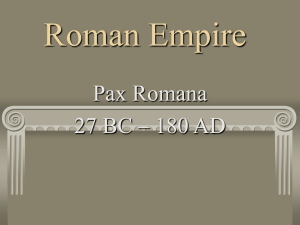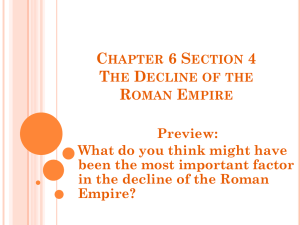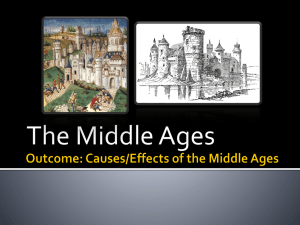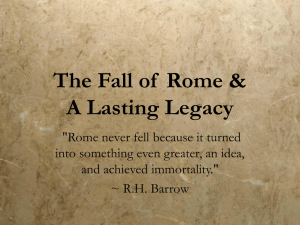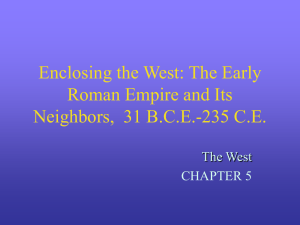The Decline of the Roman Empire
advertisement
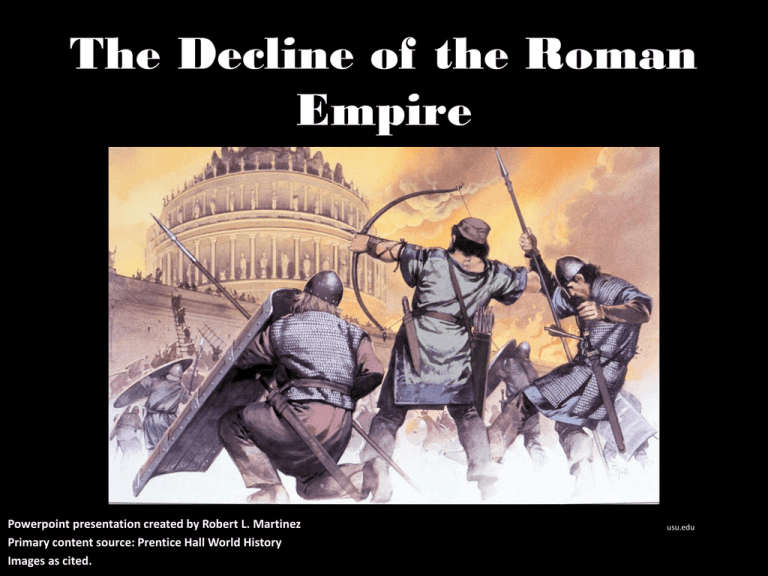
The Decline of the Roman Empire Powerpoint presentation created by Robert L. Martinez Primary content source: Prentice Hall World History Images as cited. usu.edu After the death of the emperor Marcus Aurelius in 180, the golden age of the Pax Romana ended. For the next 100 years, political and economic turmoil rocked the Roman empire. pantheism.net Again and again, emperors were overthrown by ambitious generals who seized power with the support of their troops. Those who rose to the imperial throne ruled for just a few months or years until they, too, were overthrown or assassinated. thewander-woman.com In one 50 year period, at least 26 emperors reigned. Only one died of natural causes. Political violence and instability, rather than order and efficiency - became the rule. vaticanarthistoriantours.com At the same time, the empire was shaken by disturbing social and economic trends. High taxes to support the army, and the bureaucracy placed heavy burdens on business people and small farmers. lore-and-saga.co.uk Farmland that had been overcultivated for too many years lost its productivity. whitehallvilla.co.uk Many poor farmers left their land and sought protection from wealthy landowners. Living on large estates, they worked for the landowner and farmed small plots for themselves. Although technically free, they were not allowed to leave the land. goodreads.com In 284, the emperor Diocletian set out to restore order. To make the empire easier to govern, he divided it into two parts. He kept control of the wealthier eastern part himself but appointed a co-emperor to rule the western provinces. smithsonianmag.com To slow inflation, he fixed prices for goods and services. Other laws forced farmers to remain on the land. In cities, sons were required to follow their fathers’ occupations. These rules were meant to ensure steady production of good and other goods. dir.coolclips.com In 312, the talented general Constantine gained the throne. As emperor, Constantine continued Diocletian’s reforms except for two major exceptions. en.wikipedia.org First, Constantine granted toleration for Christians. By doing so, he encouraged the rapid growth of Christianity within the empire. courses.wcupa.edu Second, he built a new capital, Constantinople, making the eastern portion of the empire, the center of power. The western Roman empire was in decline, but the east enjoyed more people and resources. tumblr.com These reforms helped hold the empire together for another century. Still, the reforms failed to stop the long-term decline. In the end, internal problems combined with attacks from outside to bring the empire down. lookandlearn.com For centuries, Rome had faced attacks from the Germanic peoples who lived east of the Rhine and north of the Danube rivers. When Rome was powerful, the legions on the frontiers were successful in holding back these invaders. theapricity.com Thousands of mile to the west, the Huns, a nomadic people, migrating across Central Asia, reached eastern Europe. These skilled riders fought fierce battles to dislodge the Germanic peoples in their path. web-books.com In response to the Huns, Germanic people began to migrate into Roman lands. Men armed with spears moved in bands along with women and children, carts and herds, hoping to settle on Roman land. angelfire.com With the empire in decline, Roman legions were hard pressed to halt the invading peoples. Under pressure from attacks, the Roman empire surrendered first Britain, then France and Spain. It was only a matter of time before foreign invaders marched into Italy and took over Rome itself. theviewfrombrittany.blogspot.com In 378, when a Roman army tried to turn back the Visigoths at Adrianople, it suffered a stunning defeat. Roman power was fading. New waves of invaders were soon hammering at Rome’s borders, especially in the west. ramparts360.com In 410, the Visigoth general Alaric overran Italy and plundered Rome. Meanwhile, the Vandals moved through Gaul and Spain into North Africa. Gradually, other Germanic peoples occupied more and more of the western Roman empire. dpaddbags.com For Rome, the worst was yet to come. Starting in 434, the Hun leader Attila embarked on a savage campaign of conquest across much of Europe. badassoftheweek.com Finally, in 476, Odoacer, a Germanic leader, ousted the emperor in Rome. Later, the historians referred to that event as the “fall” of Rome. historyguffaw.com The passing of Rome’s power and greatness was a major turning point in the history of western civilization. But why did the Roman empire fall? iml.jou.ufl.edu Perhaps the most obvious cause of Rome’s fall was the Germanic invasions. Still, these attacks were successful in part because Roman legions lacked the discipline and training of past Roman armies. ancientgames.blogspot.com Political problems contributed to Rome’s decline. First, as the government became more oppressive and authoritarian, it lost the support of the people. Growing numbers of corrupt officials undermined loyalty, too. So did frequent civil wars over succession to the imperial throne. pbs.org Perhaps most important, dividing the empire at a time when it was under attack may have weakened it beyond repair. The richer eastern Roman empire did little to support the west. explorethemed.com Economic problems were widespread in the empire. Heavy taxes were required to support the vast government bureaucracy and huge military establishment. g pennay.edublogs.or Reliance on slave labor discouraged Romans from exploring new technology. The wealth of the empire dwindled as farmers abandoned their land and the middle classes sank into poverty. In addition, the population declined as war and epidemic diseases swept the empire. toptenz.net For centuries, worried Romans pointed to the decline in values such as patriotism, discipline, and devotion to duty on which the empire was built. The need to replace citizen soldiers with mercenaries testified to the decline of patriotism. history.msu.edu The upper class, which had once provided leaders, devoted itself to luxury and self-interest. brendaatanacio.edublogs.org



